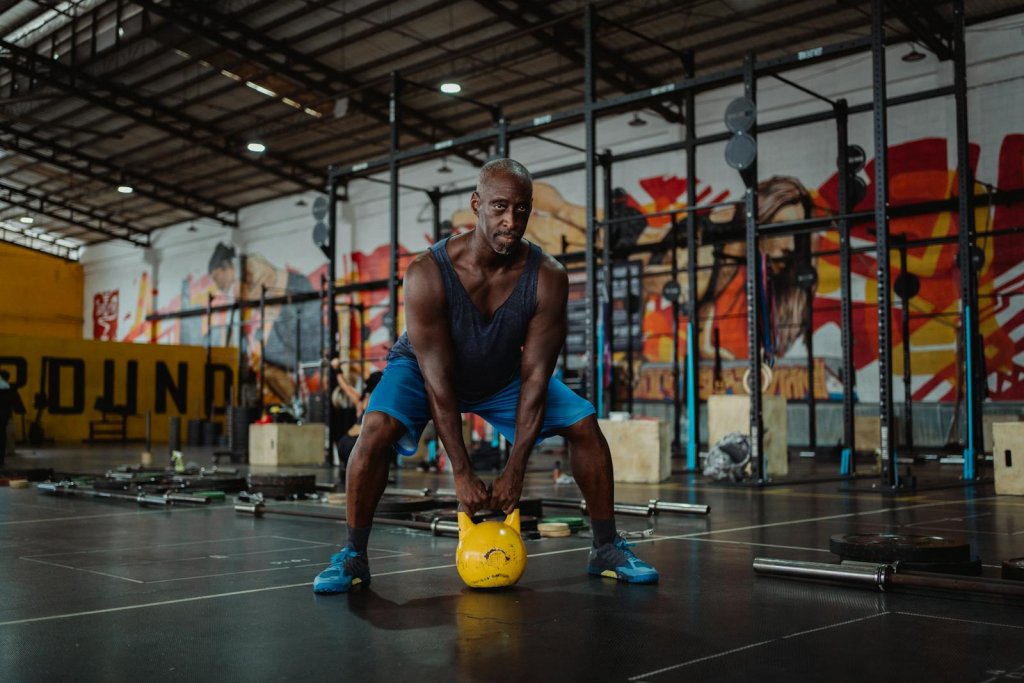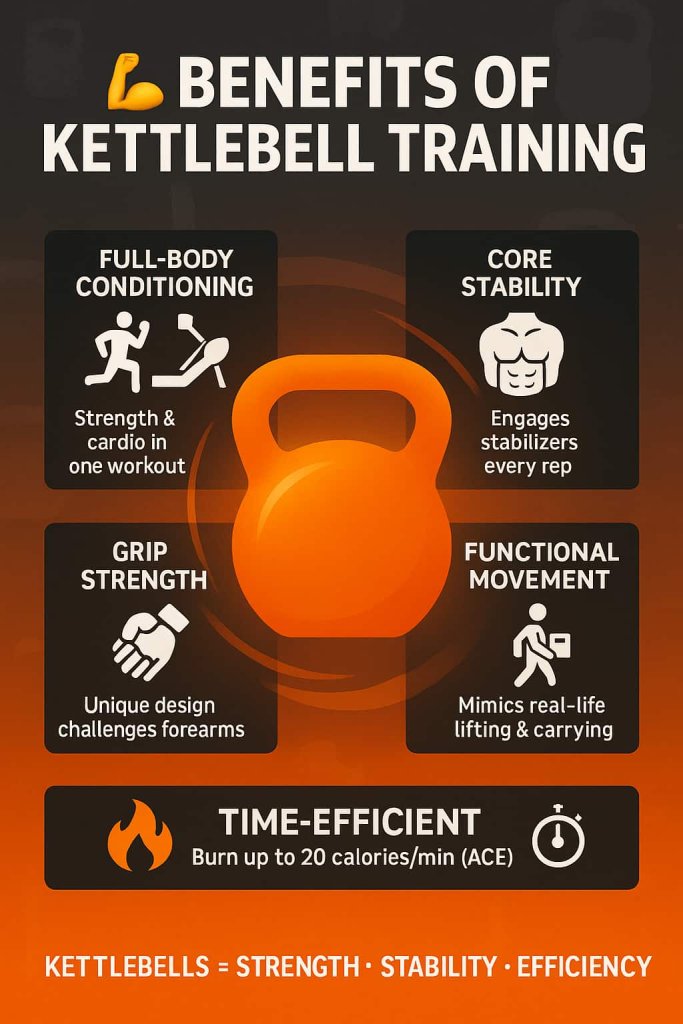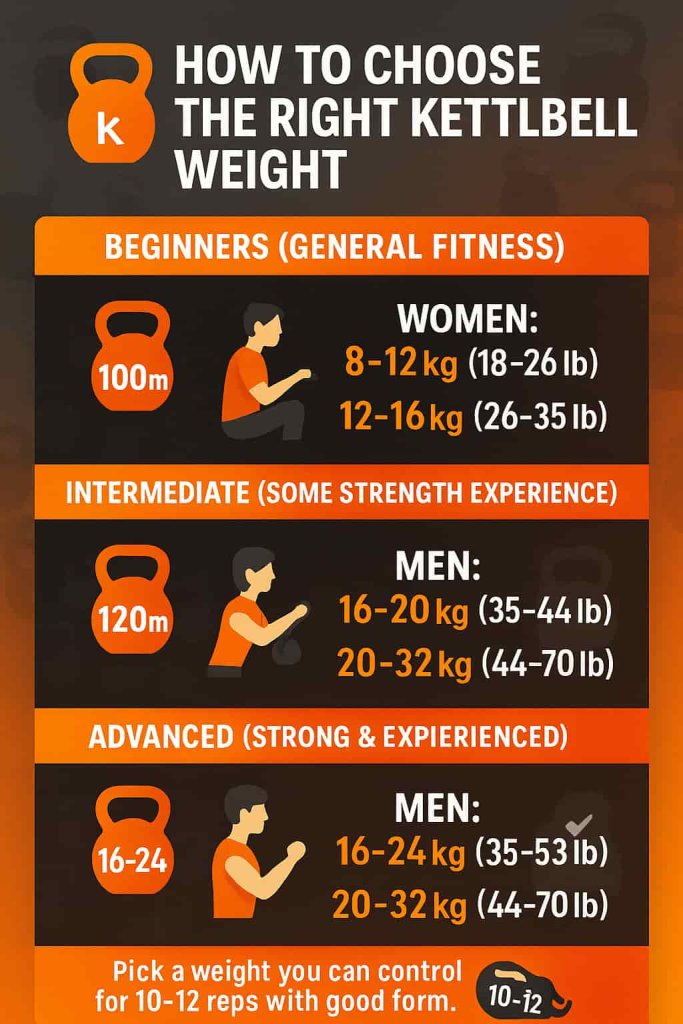The best kettlebell exercises build strength, power, endurance, and stability—all in one workout. Unlike traditional dumbbells, kettlebells allow for fluid, dynamic movements that train multiple muscles at once.

If you want to burn fat, improve core stability, and build functional strength, adding kettlebells to your routine is one of the most effective ways. In this guide, we’ll cover 17 of the best kettlebell exercises—from beginner-friendly swings to advanced Turkish get-ups—organized by training focus.
Benefits of Kettlebell Training
Before diving into the exercises, here’s why kettlebells are worth it:

- Full-body conditioning → Strength and cardio in one session.
- Core stability → Constant stabilization during dynamic moves.
- Improved grip strength → Unique handle design challenges forearms.
- Functional movement patterns → Mimics real-life lifting, carrying, and swinging.
- Time-efficient → High-calorie burn in short sessions (up to 20 calories/min per ACE research).
17 Best Kettlebell Exercises for Full-Body Strength
Kettlebells are one of the most effective training tools for building strength, power, and conditioning. Below you’ll find the 17 best kettlebell exercises, each broken down by Muscles Worked, Why It Works, How to Do It, and Trainer Tip.
1. Kettlebell Deadlift
Muscles Worked: Glutes, hamstrings, lower back, grip.
Why It Works: Builds foundational hip hinge mechanics and strengthens the posterior chain, essential for safe lifting.
How to Do It:
- Place kettlebell between feet.
- Stand tall, chest up, feet shoulder-width apart.
- Hinge at hips, bend knees slightly, and grab handle.
- Drive through heels, stand tall, and squeeze glutes.
- Lower under control.
Trainer Tip: Keep spine neutral—avoid rounding your back.
2. Kettlebell Swing (Two-Handed)
Muscles Worked: Glutes, hamstrings, core, shoulders.
Why It Works: Improves hip power, explosiveness, and cardiovascular conditioning.
How to Do It:
- Place kettlebell a foot in front of you.
- Hinge at hips, grab handle, and hike bell between legs.
- Snap hips forward to swing bell to chest height.
- Let it fall naturally, then repeat.
Trainer Tip: Drive with hips, not arms. Maintain a neutral spine.
3. Single-Arm Kettlebell Swing
Muscles Worked: Glutes, hamstrings, obliques, grip.
Why It Works: Adds unilateral challenge, strengthening core and obliques.
How to Do It:
- Set up like a two-handed swing but hold with one hand.
- Hinge at hips, swing bell forward.
- Resist torso rotation, keeping shoulders square.
Trainer Tip: Switch hands after each set or alternate mid-air.
4. Goblet Squat
Muscles Worked: Quads, glutes, core.
Why It Works: Teaches squat mechanics, builds lower-body strength, and improves mobility.
How to Do It:
- Hold kettlebell at chest height (by the horns).
- Squat down, elbows inside knees.
- Keep chest lifted and back neutral.
- Push through heels to stand tall.
Trainer Tip: Push knees outward, not forward.
5. Kettlebell Clean
Muscles Worked: Posterior chain, traps, forearms, grip.
Why It Works: Transfers kettlebell into the rack position, building explosive pulling strength.
How to Do It:
- Start with bell between legs.
- Hinge, pull kettlebell up close to body.
- Rotate wrist and “catch” bell in rack position.
- Lower and repeat.
Trainer Tip: Punch hand through—don’t let bell slam into forearm.
6. Kettlebell Front Squat
Muscles Worked: Quads, glutes, hamstrings, core.
Why It Works: Loaded in rack position, challenging legs and core simultaneously.
How to Do It:
- Rack one or two kettlebells at shoulder height.
- Keep chest tall, descend into squat.
- Push through heels to return to standing.
Trainer Tip: Engage core—avoid collapsing forward.
7. Kettlebell Overhead Press
Muscles Worked: Shoulders, triceps, core.
Why It Works: Develops pressing strength while engaging stabilizers.
How to Do It:
- Rack kettlebell at shoulder.
- Press directly overhead, biceps close to ear.
- Lower under control.
Trainer Tip: Don’t arch lower back—brace core throughout.
8. Kettlebell Push Press
Muscles Worked: Shoulders, triceps, legs, core.
Why It Works: Uses leg drive to lift heavier weights overhead, enhancing power.
How to Do It:
- Rack kettlebell.
- Dip slightly at knees and hips.
- Drive upward, pressing bell overhead.
- Lower under control.
Trainer Tip: Keep dip shallow—don’t turn it into a squat.
9. Kettlebell Snatch
Muscles Worked: Full-body—hips, back, shoulders, grip.
Why It Works: Explosive movement that builds power, conditioning, and endurance.
How to Do It:
- Start with kettlebell on floor.
- Hinge, pull explosively upward.
- Punch bell overhead, locking out.
- Lower smoothly.
Trainer Tip: Keep bell close to body—avoid wide arcs.
10. Turkish Get-Up
Muscles Worked: Core, shoulders, hips, stabilizers.
Why It Works: Improves mobility, coordination, and stability.
How to Do It:
- Lie on back holding kettlebell overhead.
- Roll to elbow, then hand.
- Bridge hips, sweep leg through.
- Stand up with kettlebell locked overhead.
- Reverse steps to return.
Trainer Tip: Break it into stages—control each step.
11. Kettlebell Windmill
Muscles Worked: Obliques, shoulders, hips, hamstrings.
Why It Works: Builds lateral core strength and improves mobility.
How to Do It:
- Hold kettlebell overhead.
- Turn feet 45°, hinge at hips.
- Lower opposite hand toward floor.
- Return to standing.
Trainer Tip: Keep eyes on kettlebell throughout.
12. Kettlebell Deadlift High Pull
Muscles Worked: Posterior chain, traps, upper back.
Why It Works: Blends hinge and pull into a powerful strength + conditioning move.
How to Do It:
- Deadlift kettlebell from floor.
- Extend hips fully, pulling bell to chest.
- Lower under control and repeat.
Trainer Tip: Lead with elbows high and wide.
13. Kettlebell Renegade Row
Muscles Worked: Lats, triceps, core, grip.
Why It Works: Combines plank stability with back strength.
How to Do It:
- Start in plank with hands on kettlebells.
- Row one bell to ribcage.
- Lower slowly, repeat other side.
Trainer Tip: Keep hips level—don’t twist.
14. Kettlebell Farmer’s Carry
Muscles Worked: Grip, traps, core.
Why It Works: Builds real-world strength, grip, and posture.
How to Do It:
- Hold heavy kettlebells at sides.
- Walk tall with shoulders back.
- Cover desired distance.
Trainer Tip: Don’t rush—control each step.
15. Kettlebell Overhead Carry
Muscles Worked: Shoulders, traps, core.
Why It Works: Builds overhead stability, posture, and endurance.
How to Do It:
- Press kettlebells overhead.
- Lock elbows and brace core.
- Walk forward, keeping arms straight.
Trainer Tip: Keep ribs tucked—avoid flaring chest.
16. Kettlebell Lunge Press
Muscles Worked: Quads, glutes, shoulders, core.
Why It Works: Combines lower- and upper-body strength into one move.
How to Do It:
- Hold kettlebell at shoulder.
- Step into lunge.
- Press kettlebell overhead as you descend.
- Return to standing.
Trainer Tip: Stabilize in lunge before pressing.
17. Kettlebell Complex (Flow)
Muscles Worked: Full-body—legs, back, shoulders, core.
Why It Works: Time-efficient sequence targeting multiple muscle groups, improving endurance.
How to Do It (Example Flow):
- 5 Swings
- 5 Cleans
- 5 Presses
- 5 Squats
- 5 Snatches
Trainer Tip: Choose moderate weight for fluid transitions.
How to Choose the Right Kettlebell Weight
Choosing the right kettlebell weight is crucial for safety and progress. Using one that’s too light won’t challenge your muscles, while one that’s too heavy increases injury risk.

- Beginners (general fitness):
- Women: 8–12 kg (18–26 lb)
- Men: 12–16 kg (26–35 lb)
- Intermediate (some strength experience):
- Women: 12–16 kg (26–35 lb)
- Men: 16–20 kg (35–44 lb)
- Advanced (strong & experienced):
- Women: 16–24 kg (35–53 lb)
- Men: 20–32 kg (44–70 lb)
👉 Rule of thumb: Choose a weight you can control for 10–12 reps with good form. Start lighter for technical moves (Turkish get-up, snatch) and heavier for simple lifts (deadlifts, carries).
For official guidance, see ACE Fitness Kettlebell Training Guidelines.
Common Kettlebell Mistakes to Avoid
Even experienced lifters make form errors with kettlebells. Fixing these mistakes ensures safer, more effective workouts:
- Rounding the back during swings → increases spinal stress.
- Using arms instead of hips → the swing should be hip-driven, not a front raise.
- Lifting too heavy too soon → progress gradually to avoid shoulder and back injuries.
- Holding the kettlebell too far from the body → keep it close for cleans, presses, and squats.
- Skipping warm-up → dynamic hip openers and shoulder mobility work are essential.
👉 Pro Tip: Record yourself doing swings or get feedback from a certified trainer to spot form issues early.
Kettlebell vs. Dumbbell vs. Barbell Training
Each training tool has its strengths. Here’s how kettlebells compare:
| Tool | Best For | Key Benefits | Limitations |
|---|---|---|---|
| Kettlebells | Power, endurance, full-body training | Builds grip, core stability, explosive strength, cardio effect | Harder to load heavy for max strength |
| Dumbbells | Isolation, hypertrophy, balanced strength | Easy progression, versatile, joint-friendly | Less dynamic than kettlebells |
| Barbells | Maximal strength, muscle growth | Heavy loads, progressive overload, strength sports | Less functional, limited mobility work |
👉 Bottom line: Use all three if possible. But if you only have space for one tool, kettlebells give the best mix of strength + cardio + mobility.
Safety Tips for Kettlebell Training
- Start with 8–12 kg (18–26 lb) for beginners (women) and 12–16 kg (26–35 lb) for men (ACE, 2025).
- Master basics (deadlift, swing, squat) before progressing.
- Always warm up hips, shoulders, and core.
- Avoid rushing through reps—focus on form.
FAQ About Kettlebell Exercises
1. What weight kettlebell should beginners start with?
Women: 8–12 kg (18–26 lb), Men: 12–16 kg (26–35 lb). Start lighter for complex moves.
2. Are kettlebells better than dumbbells?
Not better—just different. Dumbbells are great for isolation, kettlebells excel at dynamic, full-body training.
3. Can kettlebells replace cardio?
Yes, kettlebell circuits like swings and snatches provide cardio benefits while building strength.
4. How often should I do kettlebell workouts?
2–3 times per week is optimal, with rest or alternate strength training days.
5. What’s the best kettlebell exercise for beginners?
The two-handed swing and goblet squat are the best entry-level moves.
6. Do kettlebells build muscle or just endurance?
They do both—heavy lifts build muscle, high-rep swings/snatches build endurance.
7. Can I train with just one kettlebell?
Yes, most moves (swings, goblets, cleans, presses) can be done with a single bell.
Conclusion
Kettlebells are one of the most versatile tools for building strength, power, and endurance in less time. By mastering these 17 kettlebell exercises, you’ll train every muscle group, boost cardiovascular fitness, and improve real-world functional strength.
👉 Ready to transform your workouts? Grab a kettlebell, start with the basics, and progress toward advanced flows like the Turkish get-up and snatch. Your body will thank you.
